 |
|
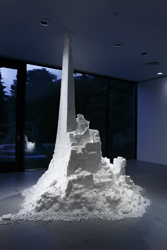 |
| Forest of This World, 2011 (17 x 9 m). One of the museum's Henry Moore sculptures can be seen through the window. Photo by Makoto Morisawa |
|
Forest of the Skyscraper, 2011 (h3.6 x w3.45 x d2.6 m). Photo by Makoto Morisawa
|
Only an hour by train from Tokyo, Hakone is a popular tourist destination blessed with some unique geology. Perched on the slopes of a huge caldera -- the remains of a volcano, once the size of nearby Mt. Fuji, that collapsed on itself back in the uncharted past -- it is a lushly primordial landscape of hot springs, sulfurous fumaroles, steep ravines, and a lovely crater lake. Situated high above the deepest valley -- but conveniently next to a station on the little railway that crawls along the slope -- is the Hakone Open-Air Museum, a sprawling array of outdoor sculptures, most of them modern and monumental, gathered from all over the world in this unlikely spot.
Opened in 1969 by the media conglomerate Fujisankei Communications Group, the Hakone was Japan's first outdoor art museum. Today it boasts some 100 sculptures dispersed across 70,000 square meters of rolling greensward and woods. Among its highlights are one of the world's largest collections of works by the English sculptor Henry Moore (1898-1986), and a Picasso Pavilion, built in 1984, that houses over 300 pieces, most of them ceramics, by the Spanish master.
The Hakone also has a large indoor museum that offers special exhibitions. Currently on display until next March 11 (first anniversary of the Great East Japan Earthquake) is a trio of gallery-sized installations, all made of salt -- a whopping seven tons of it, or approximately ten billion crystals. To the White Forest -- Forest of this world / Forest of beyond is the work of Motoi Yamamoto, a Kanazawa-based artist who began his career as a painter. Seventeen years ago his younger sister died of brain cancer, and in seeking a way to reconcile himself to the loss through art, Yamamoto was drawn to the medium of salt, a substance associated with purification and used in funeral rites in Japan. He began, he says, by sculpting large blocks of rock salt. At some point, however, he wanted to create a work evoking the contours of the brain. Struck by how the folds of the brain resemble a labyrinth, he began composing vast, intricate patterns of salt on flat surfaces.
 |
|
 |
| The artist at work on Forest of Beyond, 2011 (16.5 x 16 m). Photo by Makoto Morisawa |
|
Detail view of Forest of Beyond. Photo by Makoto Morisawa |
Working with assistants and alone, it took Yamamoto three weeks of 16-hour days to complete the three works for this exhibition. Individually titled
Forest of This World, Forest of the Skyscraper, and
Forest of Beyond, they are mutually distinct compositions, yet in tandem they tell a story. The English translation "forest" does not adequately convey the spiritual nuance of the Japanese
mori, written in this case with an unusual Kanji character that connotes a sacred grove on the precincts of a Shinto shrine.
Entering the museum, one descends a short staircase to a spacious gallery that Yamamoto has turned into a Zen-style rock garden, with salt crystals in place of raked sand and large, beautifully marbled chunks of colored salt serving as the stones. Though a broad walkway allows one to examine the garden close-up, it's a pity there are no benches to encourage leisurely contemplation of the sort one might engage in at a temple garden. The salt rocks emerge from the white expanse like carp swimming upstream in a quest, the artist says, for understanding of life and death in this world.
Going up a few steps to the next level, one enters a high-ceilinged gallery, at the center of which a tower of salt tapers to a point that stops right at the ceiling. "Forest of the Skyscraper," an unfortunately literal rendering of the Japanese, does not do justice to the ethereal quality of the tower, which, Yamamoto explains, represents the waterfall the carp seek to climb in their quest.
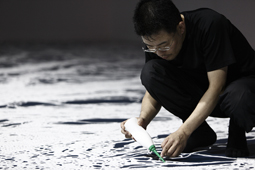 |
|
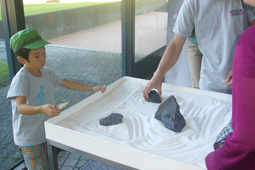 |
| The artist created Forest of Beyond using a machine-oil bottle -- "a familiar artifact from my family's bicycle shop." Photo by Makoto Morisawa |
|
Visitors young and old are encouraged to compose their own "salt gardens" in the box at the entrance to the gallery. Photo by Alan Gleason |
Climbing another flight to the third gallery, one arrives on the shore of what seems like a vast ocean of salt. This is the "Forest of Beyond," but again, a more apt translation might be "Forest of Eternity." This truly astonishing web of lacy, painstakingly traced lines of salt laps like surf at the feet of the viewer, hinting at an endless expanse of sea beyond the gallery walls.
On the symbolically chosen closing date of March 11, 2012, Yamamoto will destroy his entire installation and distribute the salt among onlookers, who will be asked to join in the final step of the project, returning the salt to the sea. As with Tibetan sand paintings, the destruction of the work is as essential as its creation, pointing to the transience of all things. As the artist clearly intends, it is a message that resonates more poignantly than ever in Japan today.
A visit to the Hakone Open-Air Museum merits the investment of a full day -- not only to appreciate the Yamamoto exhibition, but also to stroll the grounds, see the marvelous statuary therein (not to mention the Picasso collection!), and enjoy some fresh mountain air in the bargain. Though March 11 beckons with the promise of a dramatic finale to the exhibition, a trip to Hakone in November offers the equal thrill of autumn colors at their height.
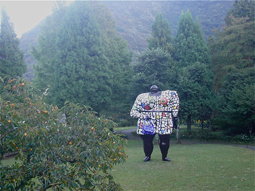 |
|
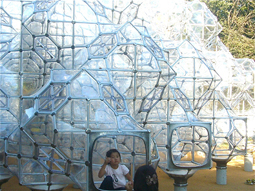 |
| Miss Black Power by Niki de Saint Phalle, 1968: one of the monumental figures that stride the pastoral grounds of the Hakone Open-Air Museum. Photo by Alan Gleason |
|
Curved Space - Diamond Structure by Peter Jon Pearce, 2011 (polycarbonate and stainless steel): the jungle gym as sculpture. Photo by Alan Gleason |
All photos by permission of the Hakone Open-Air Museum |